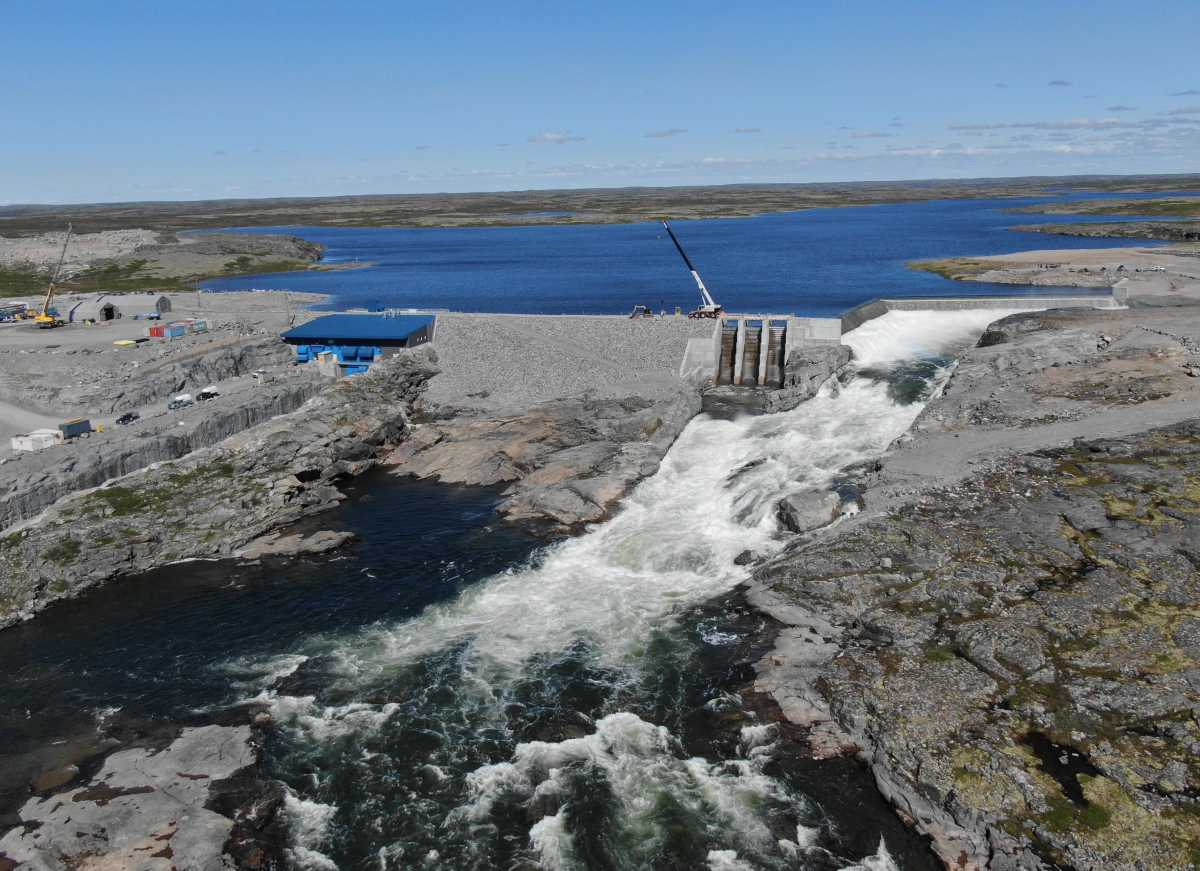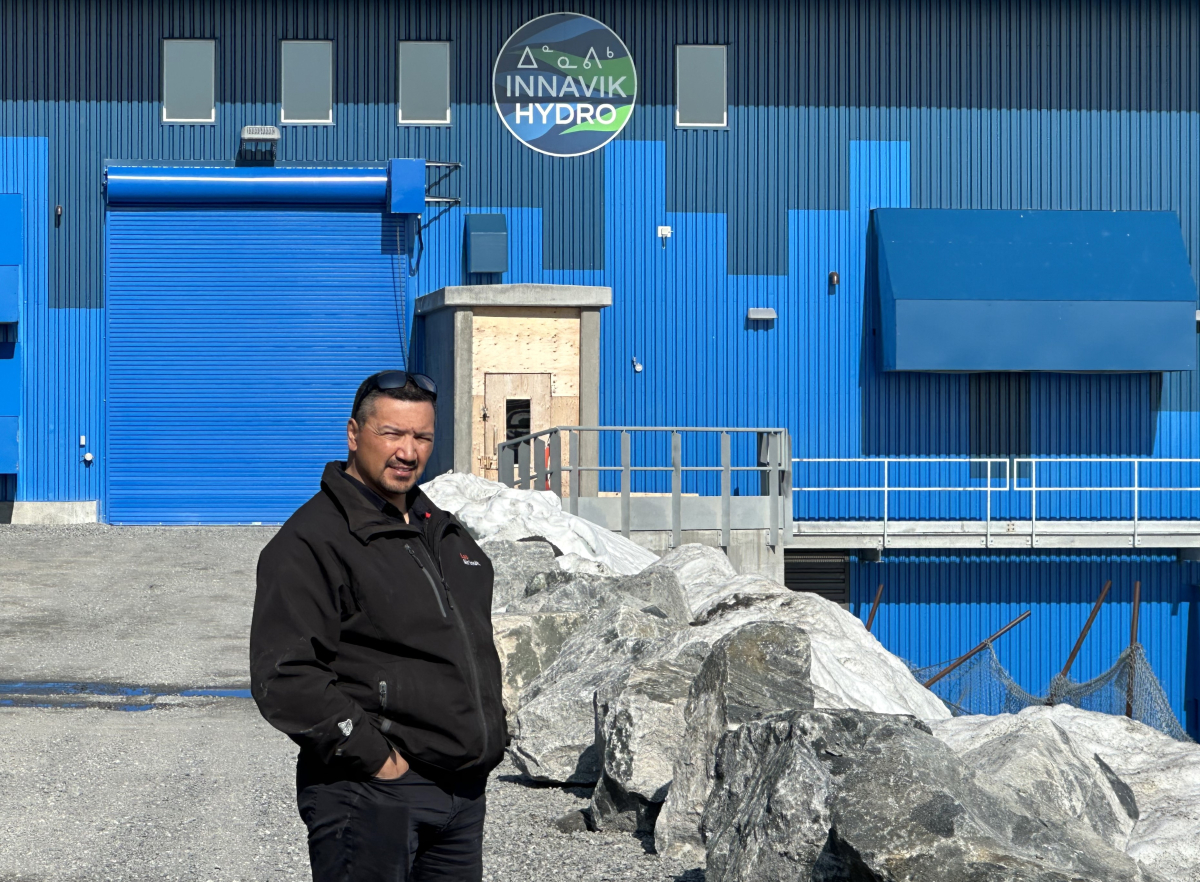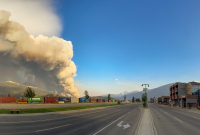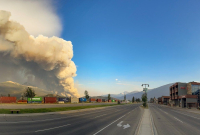Support strong Canadian climate journalism for 2025
Sarah-Lisa Kasudluak used to lie awake at night, distracted by the hum of her town’s diesel generator.
“It used to be particularly annoying in the silence," she says.
Her home, Inukjuak, should be a silent place, after all. The community is nestled against the harsh backdrop of Quebec’s Arctic region, on the eastern shore of Hudson Bay. Despite its name — which means “many people” — Inukjuak has a population of only about 2,000. Known for its extreme winters and breathtaking displays of the northern lights, it’s a place where traditional fishing and hunting have sustained its residents for generations.
But the once-frozen landscape is changing — and so is the community’s approach to energy.
Since October 2023, Inukjuak has halved its reliance on fossil fuels and aims to eliminate their use for heating and electricity in residential buildings by October 2024.
The solution has been the construction of a new hydropower facility — clean, locally generated electricity has replaced the loud noise from diesel generators across Inukjuak, including Kasudluak's home.

While Canada is ambitiously targeting a net-zero electrical grid by 2035, Inukjuak aims to entirely eliminate its use of fuel for electricity even earlier, by 2030.
It’s a major undertaking. Inukjuak has depended on diesel fuel for more than six decades to keep its lights on and houses warm. The energy source may have been vital, but it was expensive, noisy, polluting, and unreliable — and unreliability, that far north, is a potentially deadly problem.
"Fuel supply issues could leave us in the dark and cold for days," says Tommy Palliser, President of Pituvik Landholding Corporation, the Inuit-owned organization that manages the logistics for all community projects.
The logistics of importing three million liters of diesel annually were daunting in a town accessible only by sea and air. Fuel deliveries, made by tankers between July and October, were fraught with risks.
In 2015 alone, three major fuel leaks contaminated the waters and lands in Inukjuak, Ivujivik, and Salluit.
According to Palliser, Elders recall that in the 1960s, “millions of liters” leaked from a massive fuel reservoir near Inukjuak, leaving a lasting environmental impact.
The environmental damage, coupled with the constant hum of diesel generators and the smell of fuel, was a stark reminder of the community’s reliance on fossil fuels.
Inukjuak’s bold vision for a sustainable future
In Arctic Quebec, the ice is growing thinner, the snow softer, and blizzards stronger, making traditional hunting and fishing increasingly difficult.
These impacts of climate change have added urgency to the search for alternatives.
"Global warming is a real and immediate threat to our communities," Palliser says. "In November, we had a foot of ice, but now it's just a few inches thick. In February, when temperatures used to drop below minus 30 degrees, we now experience freezing rain.”
Recognizing a need for change, the community explored several green energy options, including windmills. But it was the potential of hydroelectric power that truly captivated them in 2009, when Hydro-Québec's studies revealed that a hydroelectric project offers a more reliable energy source due to the river's consistent year-round flow.
The result was Innavik, the first hydroelectric project in Arctic Quebec, so named by Pituvik — in the Inuktitut language, Innavik refers to a pouch used to carry flint and moss to start a fire.
"When we heard Hydro-Québec wanted to study the potentials of renewable energies and develop related projects, we said, 'No, this is our land, and this is going to be our project,'" Palliser stresses proudly.

And so, a 50-50 partnership between Innergex Renewable Energy and the Pituvik Landholding Corporation was born, ensuring that all project decisions and benefits would involve and receive approval from the Inuit community.
Economically, the benefits of the project will be substantial. With a community power demand of approximately four megawatts, the surplus sold to Hydro-Québec is expected to generate $90 million for Inukjuak over the next four decades.
Chris Henderson, a Canadian eco-entrepreneur who has advised the Inukjuak community on the project, highlights the importance of finding a reliable partner like Inneregex in large projects in remote northern Canada.
However, he emphasized that the unique aspect of the Innavik project was the community’s unwavering commitment to making the project succeed.
"Since 2009, with community members, we have made over 30 trips to Quebec City and met with every premier. They never gave up. We knew this was a great project, even though Hydro-Québec did not believe in this," he says.
“This project demonstrated that achieving sustainability requires persistence. You must keep working and fighting for what you believe is right.”
Kasudluak explained the significance of such projects in small, underfunded communities: “When you live in a community, you are not one individual, you are many,” she said.
"Undertaking projects like this in Indigenous territories is a step-by-step process that involves growing with our community. While this project aligns with decarbonization goals, for us, the Indigenous people, it's also about decolonization."
Challenges and triumphs
Building a run-of-river hydroelectric facility in the remote Arctic was no small feat, specifically because, Pituvik’s power corp director Eric Atagotaalukexplained, the community prioritized minimizing the project's environmental impact.
As a result, although they could have built a 144 MW facility, it opted for a small-scale 7.5 MW dam, which has a small head pond of 1.2 square kilometres and a shallow depth that minimizes the flooding impact. Moreover, given the power station’s run-of-river design, the river will continue to flow downstream as it did before the construction.
In addition to these environmental considerations, Atagotaaluk adds that navigating logistical challenges was another hurdle in building the dam in such a remote place. The construction company used a barge, towed by a tugboat, to transport equipment and supplies from Wemindji, more than 600 kilometres south in James Bay, to Inukjuak — a journey that takes about three weeks.
Despite all these difficulties, the construction of the hydroelectric power plant was completed in 2023.
The project's ecological and socio-economic benefits were enormous. By transitioning from diesel to renewable electricity, Innavik is projected to prevent 700,000 tonnes of greenhouse gas emissions over the next 40 years.
This shift also significantly reduced noise and air pollution within the community. Sarah-Lisa Kasudluak, one of the community leaders in Inukjuak, explains that the once-pervasive hum of diesel generators has faded, replaced by the quiet of clean energy.






Comments
I enjoyed reading the article and am glad to see this type of project is viable to small communities.
What would have added significantly to the article, and elevated it from a feel good press release, was a discussion of the economics:
1. How much are rate payers going to pay for the electricy?
2. What was the total cost of the project?
3. What was/will be the cost of connecting the the project to the Hydro Quebec grid?
4. What gov't subsidies were/will be given to the project?
5. How are costs/revenues to be shared between the public and private partners and for how long will the private partners be involved?
In short, what made this substantial project viable for such a small, very remote community?
(One can look at the project in Google Maps)
Some, though not all, of the project economics are discussed in this article:
https://nunatsiaq.com/stories/article/nunavik-hydro-project-secures-92-…
The basic observation is that the capital costs ($M128 is mentioned) appear to be about $64,000 for each man, woman and child of the town. How will that be paid down, via monthly hydro bills, along with the ongoing operations and maintenance costs? That remains a mystery to me.
Elsewhere, there is a reference to the project being off-grid, which seems to conflict with the idea that surplus electricity will be used elsewhere by Hydro Quebec.
????
Thanks for your probing questions and initial answers.
Perhaps N.O. can do a second part to this story soon that fully explores what you have brought to the fore.
I can't begin to imagine how horrific it would be to be inundated with the noise and sickening toxic fumes of diesel combustion. I for one wouldn't last a minute having to deal with it. May every community and road be free of the scourge of diesel fuel being burned no matter where you are.
According to this 2019 article from The Narwhal, diesel generation is the reality for almost all of northern Canada, including the Territories, Northern Ontario and Quebec and, oddly perhaps, BC. You may well have travelled through a community powered by diesel and not even realized it.
https://thenarwhal.ca/how-canadas-north-get-off-diesel/
It sounds like a lot. But there a couple of factors that make me suspect it's not so bad. Maintenance is probably a wash--they're maintaining a new thing, but not maintaining an old thing. Getting to the 64,000--first, there are reasons we don't normally use diesel generators in major southern cities, say. One is, it's really expensive. And in the north, where they have them over a barrel, it's like three times as expensive. I suspect if they were to tell us what each person up there pays for the diesel, we'd turn white as snow. Spread 64,000 over 40 years and that's only like 1600 a year, probably way less than the diesel costs per person. OK, much worse if they're paying interest on a loan, but still.
Which brings us to the second thing--sounds like they got some funding. Otherwise, why would they have needed to go talk to premiers and stuff for years? Even just scoring an interest free loan or something would make a huge difference.
Add in the electricity sales to Hydro Quebec and it starts sounding pretty good.
OK, looking at that linked article, no interest-free loan, probably a little bit of funding. Seems like it's the purchase agreement with Hydro Quebec that's doing the heavy lifting.
Maintenance costs: you may be reading these days about huge bills now due, not to mention inconvenience (yes, First-World problems), to replace infrastructure that has worn out. A recent example was the Calgary water main. It seems to me if you don't amortize maintenance over project lifetime, and tuck away the (virtual) dollars each year, then when those big expenses come around when it ain't so shiny and new anymore, you go looking for handouts from senior levels of gov't.
This article reports, very generally, revenues from surplus electricity sales to HQ of $90M over 40 years; that's a little more than $2M per year (without looking further at inflation, etc.). Hardly a windfall (given the project capital cost) but, without seeing the full accounting, it undoubtedly covers some of the costs, either capital or operating.
And it's not clear how that surplus electricity will get anywhere else to be sold. Looking at the map at this link, there aren't any towns close by.
https://ontheworldmap.com/canada/province/quebec/large-detailed-map-of-…
According to Google Earth, the nearest settlements to Inukjuaq are Sitialui (115km straight line), Puvirnituq (180km), Umiujaq (236km).
The total population of Kativik (the northernmost region of Quebec) was ~12,000 (2011),
https://en.wikipedia.org/wiki/Kativik,_Quebec
while the population of the entire Nord-du-Quebec region was about 46,000 (2021).
https://en.wikipedia.org/wiki/Nord-du-Qu%C3%A9bec
This map (ca 2016) shows no transmission capacity north of the James Bay project. HQ may have or will lay a small line to somewhere.
https://canadiangeographic.ca/articles/interactive-map-shows-hydropower…
Don't get me wrong, I think the idea of getting remote communities off of diesel generation is terrific. For this project to be any sort of model for other communities with a substantial river, with a high-enough head, adjacent or near by, all the details need to be available. And curious onlookers reading a superficial report can't formulate a reasoned opinion about it without such additional information.
I work in energy in the Yukon and have worked directly on or been adjacent to many similar projects to this one. So I can speak from that context, though I'm sure there are some things that are different with Quebec that I am unaware of.
From looking at several press releases and other sources about the project, I would be willing to bet the statement about selling 'surplus' energy is just completely incorrect. Like you said, there is nowhere for that 'surplus' to go. Power is simply being sold to the utility to be distributed to local residents.
Based on other sources, there is a financial partnership between the local Inuit-owned landholding corporation (what appears to be a very similar to our First Nations Development Corporations in the Yukon) and the private company, Innergex. This partnership acts as what is known as an 'Independent Power Producer' (IPP). All they are doing is producing power and selling it to the local utility (Hydro Quebec) through a Power Purchase Agreement (PPA), though it appears in Quebec they call these 'Electricity Supply Contracts'. The utility purchases the power, distributes and sells it to the local ratepayers. You can see the contract, in French, here:
https://www.hydroquebec.com/data/achats-electricite-quebec/pdf/contrats…
I can't speak with certainty, since I don't speak French and I can't easily translate that contract, but in the Yukon these projects are never actually being fully funded by ratepayers. In fact, the entire Yukon grid relies on external funding. Our rate base is far too small to actually support this infrastructure.
Firstly, they tend to receive major portions of the funding from Federal programs (sometimes 100% of the funding even). Ratepayers pay their standard rates but they aren't representative of the actual system cost. In the Yukon we all pay the same rates, which essentially means that ratepayers in more developed areas are partially subsidizing those in more remote communities.
It doesn't appear that this project actually received Federal funding, which is quite impressive. My guess is that the rates that Hydro Quebec is paying to purchase the power vs the rates they are charging to deliver it are incongruent. I'd imagine that's always been the case, even with the fully diesel powered system. If you look at Hydro Quebec rates, they have a special rate structure for those North of the 53rd parallel. However, it matches all their other residential rates unless the customer exceeds 40kWh/day. Meaning, like I said, that it's likely other Quebec ratepayers are effectively subsidizing their rates (and perhaps there's other external funding from Canada such as the case in the Yukon). That being said, this project is supposedly lowering Hydro Quebec's operating costs in the region. So it's a win-win.
What a cheering article this one is.
congratulations and thank you to the good people of Inukjuak. 700,000 tons of co2 is quite a bit!
This is one of those rare circumstances where the comments have added a great deal of context and information to an article.